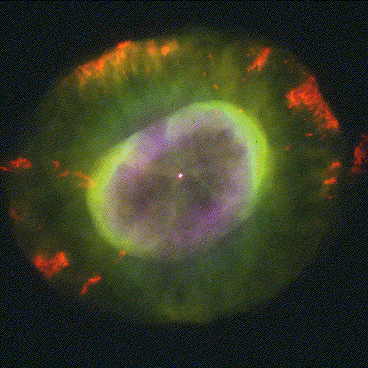 (Click on image to link to link to article on planetary nebulae)
(Click on image to link to link to article on planetary nebulae) Cosmology
This month's topic: NEBULAE
Last month's topic:
Black Holes
Nebulae:
Plural for more than one nebula.Nebula: (According to Webster's New Collegiate Dictionary) Any of many immense bodies of highly rarefied gas or dust in interstellar space.
Well, sort of. A nebula is basically a cloud of hydrogen and helium that has not yet been pulled into a gravitational field strong enough to create a nuclear fusion reaction, thus a star. In other words, it is the fetal make up of a star that has all of the components there and started, but not yet put together in form. Given enough time, (billions of years) the cloud will gravitationally pull itself into a focal point and begin the nuclear fusion reaction that occurs in a star.
It is also the after effect of a dying star when a star explodes into a nova or supernova. The hot gasses a nova releases can just mingle around in dust and gas form creating a nebula awaiting the process of rebirthing to occur again. An example of this is in the photo below. In this photo, there is one star which has undergone the process of exploding and releasing its gas, however, instead of just forming a cloud in random shape and form, it created around another star (called a BE star) which was a companion of the first. The BE star took the gas, increased its mass so much that it began to spin (either by the increased mass or by getting hit by the exploding material off center) extremely fast, flinging the extra gas out forming the disk around it. This type of nebula is called a planetary nebula.
 (Click on image to link to link to article on planetary nebulae)
(Click on image to link to link to article on planetary nebulae)
A planetary nebula is what scientists think created our solar system. There was gas left over from the sun that it formed into planets, usually gaseous such as our outer planets (Jupiter, Neptune et al.), but some rock planets like earth. These types of nebulas are what may lead to other planetary systems and may begin the formation of life elsewhere.
The above nebula is an example of an exploding star releasing its gasses outward from itself. The reason it goes in the direction it is, is due to the magnetic forces involved with stars. The gases are polarly charged as is everything in the universe, and the star has a charge and the mass to create gravity. Once this star finally explodes into a supernova, the gas will disperse more randomly and then a nebula such as the Orion Nebula can occur.
Nebulae are the beginning and end of a star's life, and are an intragal part of the cycle a universe goes through. There are many photos you can see on the internet. Just search for nebula in a search engine and there will be thousands of links to go to. The Hubble Space Telescope pages will show the greatest photos you will see (which are where the photos you see above are from). Good luck, and if you have questions or suggestions for this or any of my other cosmology pages, please email me at tinytall@oocities.com and I will attempt to correct, implement, or ignore as I see fit.
||
main||meteorology||mark||personal||links||Eric Tallberg
March 23, 1998